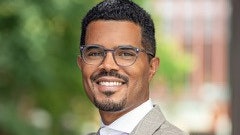By Charles H.F. Davis III, Jarell Skinner-Roy, and Brandy Jones
Yesterday morning, Leila Hamoud, a Black woman undergraduate, was arrested in her classroom at Winston-Salem State University (WSSU) by university police officers.  Dr. Charles H.F. Davis III
Dr. Charles H.F. Davis III
An unidentified staff member—who was not directly involved in the incident according to news reports—called campus police in response to an argument between the student and her professor at the professor’s request. According to Leila, who posted a since-deleted video on social media, the argument was the result of a disagreement with Cynthia Villagomez, a white Latinx professor of History, about an assignment. As the disagreement escalated – which students (who can be heard in the video of Leila’s arrest) – suggested was initiated by the professor, Leila was instructed to apologize or leave the classroom. Ultimately, when Laila refused to apologize or leave, campus police were called and placed her under arrest for what campus crime logs and court documents list as misdemeanor disorderly conduct.
This is at least the second instance this year in which a non-Black professor has been involved in treating a Black student with hostility and violence before attempting to remove them from a classroom setting. Just last month, reports and videos surfaced of now-former History professor Robert Evins Pickard shouting at a Black student at Tennessee State University (TSU). Pickard was subsequently terminated for his conduct, which TSU deemed “unprofessional” in an official statement posted on Twitter.
When taken together, and in consideration of Black student activists who have expressed how issues of harm are addressed in punitive ways, both cases are examples of the extent to which many postsecondary institutions and campus stakeholders are invested in retribution as a form of accountability. In particular, the WSSU incident is emblematic of how individual and institutional acts of retribution rely upon and utilize policing as a tactic to manage classroom incivility. It also represents the present threat of violence as a consequence for Black students who fail to comply with the authority ascribed to college and university faculty. To be sure, these logics of surveillance, control, and punishment of Black students exist in various postsecondary contexts to include predominantly white and other minority-serving institutions. They also are embodied by educators across racial identities while also targeting Black students when their behavior is deemed criminal. For instance, in March of this year it was reported that a Black professor at Perimeter College at Georgia State University called campus police on two Black students who arrived late to class. In September, the Interim Associate Vice President for Diversity and Inclusion at the University of Arizona called campus police on a ‘Disabled Black Queer’ student following a disagreement about the institutional mistreatment of Black students on campus. These recent examples only further demonstrate a lack of institutional concern for the safety of Black students. They specifically call attention to the type of institutional disregard that facilitates forcible interactions, some which have also resulted in serious bodily harm or death, between campus police and the diverse communities about whom the university so often espouses to care. Jarell Skinner-Roy
Jarell Skinner-Roy
However, to return to the arrest of Laila Hamoud, these instances taking place in institutional environments with historic missions and legacies to serve Black students and keep them safe is especially alarming. As institutions that were established to provide educational resources to Black people following emancipation and during the Reconstruction Era, HBCUs have a collective legacy and reputation for their unwavering commitment to provide Black students what historian Jelani Favors, an alumnus and the Henry E. Frye Distinguished Professor at North Carolina A&T State University, describes as a “shelter in a time of storm.” And, although it seems reasonable to excuse these instances as individual actions, the institutional response in the wake of national attention suggests WSSU is falsely equating the idea of safety with the presence and utility of police. As University Chancellor Robinson and other university officials have stated, both staff and campus police acted appropriately and in accordance with school policies and procedures to ensure the safety of students, faculty, and staff.
This perspective raises the question of how policies and procedures that encourage police intervention actually keep campus communities safer, especially when responding to incidents that do not require armed officers making arrests. A default position that prioritizes policies over people not only demonstrates failed institutional agency, but a lack of the moral and political courage historically associated with liberatory possibilities HBCUs collectively represent. As academic research and movements committed to abolition have consistently demonstrated, safety for vulnerable people and communities is incommensurable with the presence of a violent apparatus for criminalization and punishment. In our ongoing work at the Campus Abolition Research Lab, we are finding this to be especially true for educational environments in which students (and others) live, work, and learn. Brandy Jones
Brandy Jones
For these reasons, as well as innumerable others, campus abolition stands to offer HBCUs (and postsecondary institutions writ-large) a framework of possibility. Drawing on the work of Derecka Purnell, Mariame Kaba, Ruth Wilson Gilmore, W.E.B. DuBois and various other scholars, campus abolition brings together a series of considerations in which the presence of higher education can be (re)imagined as a life-affirming institution. This includes, but is not limited to, how institutions and their stakeholders think about safety beyond systems and practices that embrace and enable state and state-sanctioned violence against those disproportionately vulnerable to premature death. Further, campus abolition invites postsecondary institutions, especially those with historical and ongoing commitments to serve minoritized student populations, to divest from their commitments to criminalization and punishment as legitimizing forces for the carceral state. While this speaks explicitly to employing an armed police force, it also interrogates the emerging presence of police academies at HBCUs as attempts to diversify the always, already racist institution.
In the absence of abolition, as was the case at WSSU and elsewhere, colleges and universities remain entangled in the longstanding suppression of self-determination, political engagement, and life-making possibilities for everyday Black people. And, because we believe these entanglements to be antithetical to the distinctive mission, vision, and values of teaching and learning, especially at HBCUs, we invite institutional leaders, faculty, and students to consider this framework as an entry point to exploring alternatives. After all, abolition is as much a process as it is a product of radical imagination, the same imagination that made possible and has kept our beloved colleges and universities alive.
Dr. Charles H.F. Davis III is a faculty member in the Center for the Study of Higher and Postsecondary Education and Director of the Campus Abolition Research Lab at the University of Michigan
Jarell Skinner-Roy and Brandy Jones are higher education doctoral students and research associates in the Campus Abolition Research Lab at the University of Michigan















